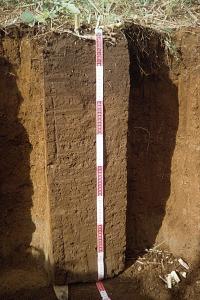Reference soil Nicaragua 07: Andosol
Andosols occur throughout the world where volcanic activity is common, especially in the circum-Pacific region and along the mid-Atlantic Ridge.
Characteristics
Soils with a vitric or andic horizon (slightly to moderately weathered horizons in pyroclastic deposits dominated by short-range-order minerals, notably allophane and imogolite) starting within 25 cm from the soil surface. In addition, they may have a histic, fulvic, melanic, mollic, umbric, ochric, duric, or cambic horizon. Other diagnostic horizons (unless buried deeper than 50 cm by volcanic deposits) are absent.
Reference soil NI007: Andosols
Moderately deep, (moderately) well drained, very dark brown to brown silty clay loam to silty loam soil developed from volcanic ejecta, derived from tuff. The soil contains fresh pyroclastic and talpetate fragments, is moderately structured and permeable and highly porous. The profile consists of three different horizon sequences separated by two thin cemented layers, in Nicaragua called "talpetate" (Bm horizon). In this part of Nicaragua the talpetate is probably of geogenetic origin (Bm horizon becomes C horizon). Due to the high erosion hazard, the area urgently needs some soil conservation measures, because otherwise the talpetate layer will outcrop at the surface and the soil will loose its agricultural potential. The profile forms part of the NIC05 to NIC09 toposequence.
